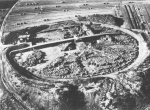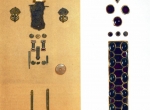Heruli
Heruli, an East Germanic →Germanic Tribes people of Scandinavian origin. They followed the trail taken by the Goths to the European mainland and eventually settled on the Sea of Azov, where they are recorded for the first time in 267. During the 3rd century they joined the Goths in their forays into the Balkans and Asia Minor. They were part of the Ostrogoth kingdom of Ermanaric and shared its fortunes when it was conquered by the →Huns . Archaeological relics from the migration of the H. to the Black Sea have not been identified and are indistinguishable from finds attributed to the Goths.
Many H. served in the Roman army, similarly as Scirii and Rugii. Dissatisfied with the refusal of their request for land in Italy they proclaimed the Scirian Odoacer as king and he went on to deal the final blow to the Western Empire.
During the second half of the 5th century the H. had a kingdom in Moravia, documented presumably by the presence in that area of small cemeteries and of a rich burial at Blučina containing an elite sword and a scabbard set with garnets. Also attributed to the H., or to the →Langobards, is a great burial mound, 65 m in diameter, discovered at Zoran (former Austerlitz – fig. 1.), with two robbed out graves and horse burials. One of these graves was identified as the burial of Silinga, daughter of Rudolf, the last king of the H. The H. of Moravia came into frequent conflicts with the →Langobards, then settled in Lower Austria; ultimately they were defeated by them between 505 and 508. After this defeat, with permission of the eastern emperor they settled to the south of the Danube, joining in 512 the Langobards or enlisting in the armies of Justinian. Some of them, with nowhere to live, set out on a return journey to Scandinavia and, according to Procopius of Caesarea: traversed all the nations of the Sclaveni one after the other, and after next crossing a large tract of barren country (presumably, Silesia and Lusatia, them depopulated) came to the Varna, in central Germany or in Brandenburg, moving on to Jutland and crossing the Baltic to Scandinavia.
The archaeological record from the burial site at Ulów, Tomasz Lubelski district, have been attributed to the returning H.: e.g., brooches and buckles, dating to the 5th century, some, possibly, to the 6th. Also linked with the H. are some late forms recorded in the Masłomęcz Group in the Basin of Hrubieszów. However, until their comprehensive publication we cannot resolve whether they actually may be attributed to the H. migrating north.
MM
Literature: L. Schmidt, Geschichte der deutschen Stämme bis zum Ausgang der Völkerwanderung. Die Ostgermanen, München 1941; W. Menghin (ed.), Germanen, Hunnen und Awaren. Schätze der Völkerwanderungszeit, Nürnberg 1987; K. Godłowski, Europa barbarzyńska od IV w. p. n. e. do VI w. n. e. w świetle źródeł pisanych [in:] M. Parczewski (ed.), Pierwotne siedziby Słowian, Kraków 2000, p. 15-45; K. Godłowski, Ziemie polskie w okresie wędrówek ludów [in:] M. Parczewski (ed.), Pierwotne siedziby Słowian, Kraków 2000, p. 309-344; B. Niezabitowska, Herulowie [in:] J. Andrzejowski, A. Kokowski, Ch. Leiber (ed.), Wandalowie, strażnicy bursztynowego szlaku. Katalog wystawy, Lublin-Warszawa 2004, p. 271-274; A. Kokowski, Starożytna Polska. Od trzeciego stulecia przed narodzeniem Chrystusa do schyłku starożytności, Warszawa 2005; B. Niezabitowska-Wiśniewska, Archaeology, History and the Heruls. The Lublin Region in the Late Roman Period and the Migration Period, Barbaricum 8, 2009, p. 195-239; J. Tejral, Langobardische Fürstengräber nördlich der mittleren Donau [in:] U. v. Freeden, H. Friesinger, E. Wamers (eds.), Glaube, Kult und Herrschaft. Phänomene des Religiösen im 1. Jahrtausend n. Chr. in Mittel- und Nordeuropa, Kolloquien zur Vor- und Frühgeschichte 12, Bonn 2009, p. 123-162; M. Mączyńska, Światło z popiołu. Wędrwówki ludów w Europie w IV i V w., Warszawa 2013, esp. p. 239-241.
-
 full resolution
full resolution
Fig. 1. The burial mound at Žuraň in Moravia during excavation in 1947 (W. Menghin 1987).
-
 full resolution
full resolution
Fig. 2. A sword with a gold hilt and scabbard set with garnets from the Blučina-Cezavy burial in Moravia (W. Menghin 1987).


